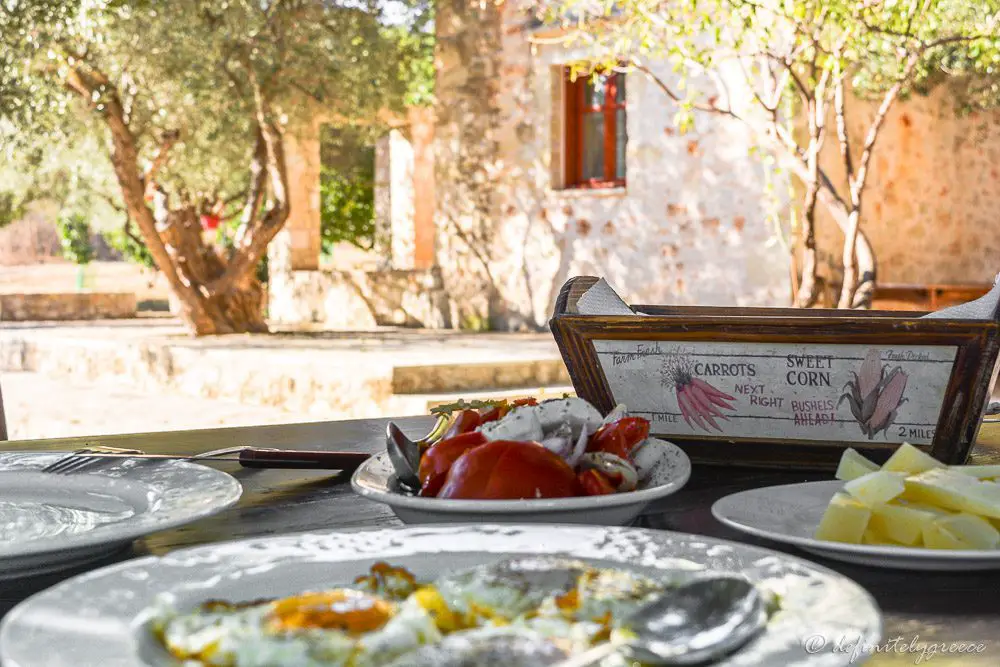You are 2-minutes reading time away from the perfect Greek salad! Salads are standard fare for lunch, dinner and brunch in Greece. Especially at the end of spring and during summer when all Greek fresh products are in season. The traditional Greek salads are fresh, vibrant and delicious.
The Horiatiki (=Village) Greek salad is not a complicated endeavour and remains consistent in terms of ingredients and presentation. But within this simplicity also lies the trap. Pay close attention to the ingredients below and for the love of all that is sacred, put the lettuce down!
Here is what you put in:
The Greek salad within Greece is fairly standard.
Same fresh ingredients, same simple presentation and same mouth-watering flavours every single time. It is true that in different places around the country you may come across a local version. In Santorini or Mykonos, for example, a few extra ingredients are thrown into the mix. But in general, when you ask for a Horiatiki, here is what you will get every single time:
A base of veggies, tomatoes, cucumbers, olives and cheese. No lettuce or any other fresh leafy greens.
Large chunks of tomatoes. No cherry or grape tomato, just full-size ripe tomatoes chopped into wedges.
Mega block of feta. Greeks are really proud of their delicious sheep’s milk fresh cheese called feta. And feta is the star of the dish, served in a huge block on the top of the salad. It’s never crumbled, it is just sitting on the top ready to be smashed into small uneven pieces/ bites.
Green bell peppers. No red, orange or yellow bell pepper. Just bright green bell peppers, cut horizontally into strips.
Kalamata olives with the pits, always.
Well, roll up your sleeves and get ready to make the most delicious traditional Greek salad. You will need these ingredients:
- Tomatoes: fresh, ripe, in-season tomatoes cut into wedges.
- Cucumber: Either Persian or English cucumbers will do, cut into slices
- Green bell pepper: Fresh and cool green bell pepper, cut into srips
- Red onion: Usually cut into thin slices.
- Kalamata olives: Always whole, never pitted.
- Feta: Made from sheep’s milk, and always served in a large chunk.
- Extra Virgin Olive oil: it is strongly recommended to look for a very good quality olive oil, as it is the only ingredient that will dress up your salad.
- Dried Oregano: Sprinkled on the top, it adds a discreet but incomparable odour.
- Sea salt: in moderation as the fest cheese is pretty salty by itself.
Optional but delicious additions:
- Red wine vinegar: Very often Greek salads are served with a generous splash of red (or white) wine vinegar, which gives a very fresh touch.
- Capers: Some Greeks garnish their salads with this wild vegetable with the unique aroma and sharp taste.
- Whole grain rusks: Add these dried bread bites that will soak the tomato juices and the olive oil, as you must not miss even a drop of this heavenly mixture.
Assembling
Place your tomatoes, cucumbers, peppers and onions in a large salad bowl.
Add a good handful of the pitted kalamata olives.
Season very lightly with just a small pinch of salt.
Now place the block of creamy feta cheese gently on the top.
Sprinkle the dried oregano and pour the olive oil.
Serve with crusty bread for dunking.
*This is usually combined with any grilled meat, fish or vegetable meal. I mean, it pretty much will make an appearance on the table every day. You know what else? It is also a full meal by itself, so no need to ever go without!
The Greek ritual of eating the Horiatiki!
When this lovely dish arrives at the table one of the people will usually step forward and make sure that it is ready to be served. This could be the mother, the person standing closest or anyone that is eagerly waiting to eat with a knife and fork in hand. The first step is, of course, crumbling the feta to bits. That is followed by the tossing of all the fresh veggies so that each individual piece is baptized into the oil and tomato juice. A most sacred task indeed!
This salad contains all the ingredients to make it a full and wholesome meal. In fact it is a superfood as it has everything the body needs: lots of vitamins and fibre from the vegetables (tomato, pepper, cucumber and onion), carbohydrates and more fibre from the accompanying bread or rusk often used for dunking, good fatty acids from the olive oil and proteins and animal fat from the feta. You can have flavour and a healthy diet all in one.
Can you think of anything better to start your authentic Greek experience than this delicious salad?
‘kali orexi’ (bon appétit)!
Let’s play a game of guess the salad:
Is this a Greek salad?
No! If you didn’t pick up on this, you may need to go back and read the ingredient list carefully again.
Is this a Greek salad?
Yes! There is no generous olive oil visible, but we are going to give this the benefit of the doubt and assume that it is one of the cases where a customer is free to pour as much as they see fit.
Is this a Greek salad?
No. No. No. What is this? An orange and an apple? I mean, would I eat it? Yes! It has fruits and veggies and olive oil, which are all incredibly good for you and tasty but under no stretch of the imagination would it qualify.
Is this a Greek salad?
They aim to confuse us. Fresh tomatoes on the right, a few green herbs on the left. A whole heap of olives and some lovely dipping oil. But what hides under this pile of goodness, I ask you? Lettuce that is what. If you still answered yes, I have failed at this lesson.
Is this a Greek salad?
Posting this picture was almost too much. Even now typing these words I have to avert my eyes from the screen. No words.
Is this a Greek salad?
There it is! So effortlessly perfect. Even the plate has a Greekness about it. Solid effort! Job well done.



























